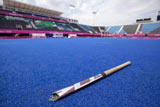
Sports: Athletics
The Olympic Stadium will host the four spectacular Opening and Closing Ceremonies at London 2012, as well as some of the most iconic Games events.
The Stadium is at the heart of the Olympic Park on an 'island' site, surrounded by waterways on three sides. Spectators will reach the venue via five bridges that link the site to the surrounding area.
The design and build
The innovative flexible design of the Olympic Stadium means its 80,000 capacity can be reduced after the Games. It has a permanent lower tier with a capacity of 25,000, and a temporary steel and concrete upper tier, which holds a further 55,000 spectators, that can be dismantled after the Games.
The temporary upper tier means that amenities such as catering and toilets normally found inside sports stadia have been located in temporary facilities around the outside of the Stadium.
Facilities for athletes within the Stadium include changing rooms, medical support facilities and a 60m warm-up track.
An Olympic Stadium with such a large removable element and mix of permanent and temporary seating has never been attempted before.
The Stadium is also the most sustainable ever built for an Olympic Games. The lower tier sits within a bowl in the ground, which minimises the use of construction materials. This bowl was created by excavating 800,000 tonnes of soil, the majority of which was cleaned and reused elsewhere on the Olympic Park.
Around 10,000 tonnes of steel were used to build the venue – significantly less than in other Olympic stadiums, making its construction more sustainable. The top ring of the Stadium was built using surplus gas pipes – a visual testament to London 2012's efforts to 'reduce, reuse and recycle'.
Construction began in May 2008 and was completed in just under three years, with the final piece of turf laid in March 2011.
After the Games
The Stadium is designed to be flexible enough to accommodate a number of different requirements and capacities in legacy. It will retain athletics at its core, and also be a venue for other sporting, cultural and community events.
It will be the venue for the 2015 IAAF World Championships
The?London Legacy Development Corporation and Mayor of London Boris Johnson have taken the decision to keep the Stadium under public ownership.

















